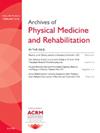Identifying and Prioritizing Recommendations to Optimize Transitions Across the Care Journey for Hip Fractures: Results From a Mixed-methods Concept Mapping Study in Ontario, Canada 1130
IF 3.6
2区 医学
Q1 REHABILITATION
Archives of physical medicine and rehabilitation
Pub Date : 2025-04-01
DOI:10.1016/j.apmr.2025.01.055
引用次数: 0
Abstract
Objectives
To create a list of actionable and prioritized recommendations to improve care transitions for individuals with hip fracture from the perspectives of persons with lived experience, care partners, health care providers, and decision-makers.
Design
Mixed methods, concept mapping study.
Setting
Ontario, Canada.
Participants
Participants included persons who had experienced a hip fracture, care partners, health care providers, and decision-makers. All participants were required to be ≥18 and speak English. Persons with lived experience were required to have received care for a hip fracture in Ontario; care partners were required to have provided care for an individual who experienced a hip fracture; health care providers and decision-makers were required to have provided care in a paid capacity for individuals with hip fracture or to influence policy or procedures relating to hip fracture. We used a multipronged purposive sampling strategy to recruit participants.
Interventions
Not applicable.
Main Outcome Measures
Perspectives of key stakeholders on what is needed to improve care transitions for hip fracture.
Results
The final cluster map selected by participants was an 8-cluster map, with the following cluster labels: (1) access to inpatient services and supports across the care continuum; (2) informed and collaborative discharge planning; (3) access to transitional and outpatient services; (4) communication, education and knowledge acquisition; (5) support for care partners; (6) person-centered care; (7) physical, social, and cognitive activities and supports; and (8) provider knowledge, skills, roles and behaviors. Provider knowledge, skills, roles and behaviors was rated by participants as the most important cluster.
Conclusions
Our study findings highlight the importance of person-centered care, with active involvement of persons with lived experience and their care partners throughout the care journey. This study provides insights for future interventions and quality improvement initiatives for enhancing transitions in care among hip fracture populations.
Disclosures
none.
求助全文
约1分钟内获得全文
求助全文
来源期刊
CiteScore
6.20
自引率
4.70%
发文量
495
审稿时长
38 days
期刊介绍:
The Archives of Physical Medicine and Rehabilitation publishes original, peer-reviewed research and clinical reports on important trends and developments in physical medicine and rehabilitation and related fields. This international journal brings researchers and clinicians authoritative information on the therapeutic utilization of physical, behavioral and pharmaceutical agents in providing comprehensive care for individuals with chronic illness and disabilities.
Archives began publication in 1920, publishes monthly, and is the official journal of the American Congress of Rehabilitation Medicine. Its papers are cited more often than any other rehabilitation journal.

 求助内容:
求助内容: 应助结果提醒方式:
应助结果提醒方式:


